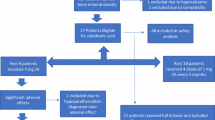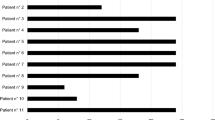Abstract
One of the most common complications in thalassemia major patients is osteopenia and osteoporosis. In this study, we compare the therapeutic effect of two treatment protocols involving infusion of 45 mg of pamidronate injection every 6 weeks (P45) and 90 mg pamidronate infusion every 4 weeks (P90). Bone mineral density was measured using dual energy X-ray absorptiometry (DEXA). Z-score of lumbar vertebra (as L total) and the femoral head (as F total) were compared before and after administration of two protocols. Bone density between the two groups was compared by Student t test and by the paired t test before and after the intervention. Data were analyzed using SPSS (18). Ninety-one patients were treated with pamidronate 45 mg (P45), and 36 patients were treated with pamidronate 90 mg (P90). Ninety-one and 36 patients received P45 and P90 protocol, respectively. Mean age was 29.4 ± 8.1 and 30.9 ± 8.0 years old in P45 and P90 groups, respectively. Sixty-two and 58 % of P45 and P90 group were female. The means of F total were −1.73 ± 1.11 and −1.47 ± 0.92 before and after treatment in patients P45 (P = 0.01) and were −1.83 ± 0.75 and −1.57 ± 0.99 in group P90 (P = 0.005), respectively. Before treatment, the means of L total were −2.95 ± 0.81 and −2.92 ± 0.66 (P = 0.8) and after treatment were −2.53 ± 1.13 and 2.81 ± 0.98 (P = 0.1) in P45 and P90 groups, respectively. In P45, between the mean of L total was statistically significant difference before and after treatment (P < 0.0001); however, there was no significant difference in the P90 group (P = 0.3). The study showed effectiveness of both protocols. As the medication is expensive and should be administrated parenterally, we recommend P45 protocol which is less expensive with fewer injections.
Similar content being viewed by others
References
Wonke B, Jensen C, Hanslip J, Prescott E, Lalloz M, Layton M et al (1997) Genetic and acquired predisposing factors and treatment of osteoporosis in thalassaemia major. Journal of pediatric endocrinology & metabolism: JPEM 11:795–801
Terpos E, Voskaridou E (2010) Treatment options for thalassemia patients with osteoporosis. Ann N Y Acad Sci 1202(1):237–43
Voskaridou E, Terpos E, Spina G, Palermos J, Rahemtulla A, Loutradi A et al (2003) Pamidronate is an effective treatment for osteoporosis in patients with beta-thalassaemia. Br J Haematol 123(4):730–7
Voskaridou E, Kyrtsonis MC, Terpos E, Skordili M, Theodoropoulos I, Bergele A et al (2001) Bone resorption is increased in young adults with thalassaemia major. Br J Haematol 112(1):36–41
Voskaridou E, Terpos E (2004) New insights into the pathophysiology and management of osteoporosis in patients with beta thalassaemia. Br J Haematol 127(2):127–39
Kosaryan M, Vahidshahi K, Jamali AE, Sarparast L (2012) Bone mineral density (BMD) of patients with beta thalassemia, Thalassemia Research Center, 2007. Journal of Mazandaran University of Medical Sciences (JMUMS) 22(86)
Di Stefano M, Chiabotto P, Roggia C, Garofalo F, Lala R, Piga A et al (2004) Bone mass and metabolism in thalassemic children and adolescents treated with different iron-chelating drugs. J Bone Miner Metab 22(1):53–7
Origa R, Fiumana E, Gamberini M, Armari S, Mottes M, Sangalli A et al (2005) Osteoporosis in β-thalassemia: clinical and genetic aspects. Ann N Y Acad Sci 1054(1):451–6
Dundar U, Kupesiz A, Ozdem S, Gilgil E, Tuncer T, Yesilipek A et al (2007) Bone metabolism and mineral density in patients with beta-thalassemia major. Saudi Med J 28(9):1425–9
Pietrapertosa A, Minenna G, Colella S, Santeramo T, Renni R, D'Amore M (2009) Osteoprotegerin and RANKL in the pathogenesis of osteoporosis in patients with thalassaemia major. Panminerva Med 51(1):17–23
Voskaridou E, Terpos E (2008) Pathogenesis and management of osteoporosis in thalassemia. Pediatric endocrinology reviews: PER 6:86–93
Scacchi M, Danesi L, Cattaneo A, Valassi E, Giraldi FP, Argento C et al (2008) Bone demineralization in adult thalassaemic patients: contribution of GH and IGF-I at different skeletal sites. Clin Endocrinol (Oxf) 69(2):202–7
Mahachoklertwattana P, Pootrakul P, Chuansumrit A, Choubtum L, Sriphrapradang A, Sirisriro R et al (2006) Association between bone mineral density and erythropoiesis in Thai children and adolescents with thalassemia syndromes. J Bone Miner Metab 24(2):146–52
Vogiatzi M, Autio K, Schneider R, Giardina PJ (2004) Low bone mass in prepubertal children with thalassemia major: insights into the pathogenesis of low bone mass in thalassemia. J Pediatr Endocrinol Metab 17(10):1415–22
Perrotta S, Cappellini MD, Bertoldo F, Servedio V, Iolascon G, D'agruma L et al (2000) Osteoporosis in β-thalassaemia major patients: analysis of the genetic background. Br J Haematol 111(2):461–6
Christoforidis A, Kazantzidou E, Tsatra I, Tsantali H, Koliakos G, Hatzipantelis E et al (2007) Normal lumbar bone mineral density in optimally treated children and young adolescents with B-thalassemia major. Hormones 6:334–40
Morabito N, Lasco A, Gaudio A, Crisafulli A, Di Pietro C, Meo A et al (2002) Bisphosphonates in the treatment of thalassemia-induced osteoporosis. Osteoporos Int 13(8):644–9
Naderi M, Zakeri Z, Dorgalaleh A, Alizadeh S, Tabibian S, Bamedi T (2014) Effect of pamidronate on osteoporosis in patients with β-thalassemia major. Iranian Journal of Blood and Cancer 6(3):149–53
Tsartsalis A, Lambrou G, Savvidis C, Chrousos G, Kattamis A (2015) Thalassemia-induced osteoporosis and bisphosphonate treatment: a systematic review and meta-analysis. 17th European Congress of Endocrinology EP 286. doi:10.1530/endoabs.37.EP286
Kosaian M (2011) The effect of intravenous biphosphonates in thalassemic patients with osteoporosis. In: 12th International Conference on Thalassemia, Turkey, 11–18 May
Giusti A (2014) Bisphosphonates in the management of thalassemia-associated osteoporosis: a systematic review of randomised controlled trials. J Bone Miner Metab 32(6):606–15
Acknowledgments
This research has been supported by Mazandaran University of Medical Science.
Author information
Authors and Affiliations
Corresponding author
Ethics declarations
Conflict of interest
The authors declare that they have no conflict of interest.
Rights and permissions
About this article
Cite this article
Kowsaryan, M., Zafari, M. Which pamidronate protocol is the best for treating osteoporosis in beta-thalassemia major?. Ann Hematol 95, 383–386 (2016). https://doi.org/10.1007/s00277-015-2564-z
Received:
Accepted:
Published:
Issue Date:
DOI: https://doi.org/10.1007/s00277-015-2564-z




